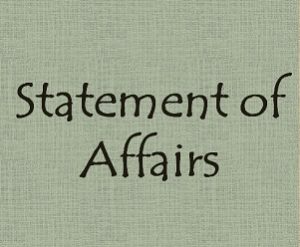Statement of Affairs
Statement of Affairs method:
Learning Objectives:
-
Define and explain statement of affairs.
-
What is the purpose of preparing a statement of affairs?
-
Prepare the format of statement of affairs.
Definition and Explanation:
Correct final accounts of a business can be prepared in the records are maintained under the double entry system . How every where the record is incomplete, and it is not all possible to complete it by double entry, in such cases the final accounts can be only approximately prepared by means of a statement of affairs. In appearance the statement of affairs is similar to a balance sheet. For this purpose, two comparative statement of affairs are prepared – one at the commencement of the year and other at the end of the year. The excess of the assets over the liabilities as shown by the statement will represent the capital of the firm. If capital at the end shows an increase as compared to the amount of capital at the start the difference will represent profit and if the capital at the end is less than the capital at the beginning the difference will be loss. In this calculation, however, two more factors should be taken into account.
-
Where fresh capital has been introduced into the business during the account period, the closing capital may be taken to have been increased to that extent. To arrive at the true profit or loss, therefore, the amount of fresh capital introduced is deducted from the closing assets as determined under such circumstances.
-
Where drawings have been made by the proprietor during the accounting period, such drawings reduce the amount of capital at the close. In order to calculate net profit, it is necessary, therefore, that amount withdrawal should be added to the capital at the close before deducting from it the capital at the beginning.
Formula:
Formula for determining the net profit is put as follows:
(Capital at the end + Drawings – Additional capital introduced) – Capital in the beginning |
Example:
Rashid and Co. keeps his book on single entry system. his position on 1st January, 19991 was as follows:
Cash in hand $200, cash at bank $3000; stock in trade $20,000; sundry debtors $8,500; furniture $1,800; machinery $15,000; sundry creditors $22,000.
On 31st December, 1991 the financial position was as follows:
Cash in hand $300; cash at bank $2,000; machinery $27,000; furniture $1,500; sundry debtors $14,000 stock in trade $19,000 sundry creditors $29,000.
During the year Rashid introduced a new capital of $5,000 and withdrew for his personal expenditure $9,000.
From the above figures, prepare a statement showing the profit or loss made by him during 1991.
Solution:
Rashid & Co.
Statement of Affairs as at 1st January, 1991.
| Liabilities | $ | Assets | $ |
| Sundry creditors Capital (balancing figure*) |
22,000 |
Cash in hand Cash at bank Sundry debtors Stock in trade Furniture Machinery |
200 |
|
48,500 |
48,500 |
* 48,500 – 22,000
Rashid & Co.
Statement of Affairs as at 1st January, 1991.
| Liabilities | $ | Assets | $ |
| Sundry creditors Capital (balancing figure*) |
29,000 |
Cash in hand Cash at bank Sundry debtors Stock in trade Furniture Machinery |
300 |
|
63,800 |
63,800 |
* 63,800 – 29,000
Statement of Profit for the year ending 31st December, 1991.
| Capital 31st December, 1991 | 34,800 |
| Add drawings during the year | 9,000 |
|
|
|
| 43,800 | |
| Less capital introduced during the year | 5,000 |
|
|
|
| 38,800 | |
| Less capital as at 1st January, 1991 | 26,500 |
|
|
|
| Net profit during the year | 12,300 |
